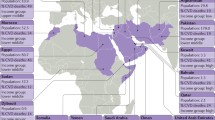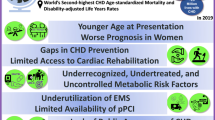Abstract
As the most populous country worldwide, China has ≈ 290 million patients with cardiovascular diseases (CVDs), representing the leading cause of death in Chinese population. The morbidity and mortality of CVDs are continuously rising. Here, we will first summarize the recent advance in the management of CVDs such as coronary arterial disease, arrhythmia, and heart failure in China. In particular, we will introduce the development of chest pain centers and indicate the novel techniques and methods applied for the management of CVDs. Then, we will discuss and point out the importance of improving the clinical and basic research for Traditional Chinese medicine in the treatment of CVDs. Finally, we will emphasize the efforts made to promote cardiac rehabilitation and cardiovascular prevention system in China. We are striving to establish a practical prevention-treatment-rehabilitation system and looking forward to a bright future with reduced morbidity and mortality from CVDs in China.
Similar content being viewed by others
References
Roth, G. A., Johnson, C., Abajobir, A., Abd-Allah, F., Abera, S. F., Abyu, G., et al. (2017). Global, regional, and national burden of cardiovascular diseases for 10 causes, 1990 to 2015. J Am Coll Cardiol, 70(1), 1–25.
National Center for Cardiovascular Diseases, China (2018). Report on Cardiovascular Diseases in China 2017. Beijing: Encyclopedia of China Publishing House.
Bei, Y., Yang, T., & Xiao, J. (2018). Cardiovascular medicine in China: what can we do to achieve the Healthy China 2030 plan? BMC Med, 16(1), 132.
Benjamin, E. J., Virani, S. S., Callaway, C. W., Chamberlain, A. M., Chang, A. R., Cheng, S., et al. (2018). Heart disease and stroke statistics-2018 update: a report from the American Heart Association. Circulation, 137(12), e67–e492.
Section of Interventional Cardiology of Chinese Society of Cardiology of Chinese Medical Association, Specialty Committee on Prevention and Treatment of Thrombosis of Chinese College of Cardiovascular Physicians, Editorial Board of Chinese Journal of Cardiology. (2016). Chinese guideline for percutaneous coronary intervention (2016). Chin J Cardiol, 44(5), 382–400.
Han, Y. L., & Rutherford, J. D. (2017). Recent evolution of the treatment of coronary artery disease in China: a conversation with Ya-Ling Han, MD, PhD. Circulation, 136(24), 2298–2302.
Tajti, P., Burke, M. N., Karmpaliotis, D., Alaswad, K., Werner, G. S., Azzalini, L., et al. (2018). Update in the percutaneous management of coronary chronic total occlusions. JACC. Cardiovascular Interventions, 11(7), 615–625.
Pu, J., Ding, S., Ge, H., Han, Y., Guo, J., Lin, R., et al. (2017). Efficacy and safety of a pharmaco-invasive strategy with half-dose alteplase versus primary angioplasty in ST-segment-elevation myocardial infarction: EARLY-MYO Trial (Early Routine Catheterization After Alteplase Fibrinolysis Versus Primary PCI in Acute ST-Segment-Elevation Myocardial Infarction). Circulation, 136(16), 1462–1473.
Wu, H., Wang, Q., Zhou, J., Qian, J., & Ge, J. (2014). First report of stent thrombosis after a switch therapy resulting from ticagrelor-related dyspnea. International Journal of Cardiology, 176(3), e127–e128.
Qin, Q., Ma, J., Li, C., Ge, L., Qian, J., & Ge, J. (2015). Accidental extraction of a stent implanted 3 years earlier by a dislodged stent: a rare complication of percutaneous coronary intervention. JACC Cardiovasc Interv, 8(12), e197–e198.
Han, Y., Guo, J., Zheng, Y., Zang, H., Su, X., Wang, Y., et al. (2015). Bivalirudin vs heparin with or without tirofiban during primary percutaneous coronary intervention in acute myocardial infarction: the BRIGHT randomized clinical trial. JAMA, 313(13), 1336–1346.
Gao, R., Yang, Y., Han, Y., Huo, Y., Chen, J., Yu, B., et al. (2015). Bioresorbable vascular scaffolds versus metallic stents in patients with coronary artery disease: ABSORB China Trial. J Am Coll Cardiol, 66(21), 2298–2309.
Han, Y., Xu, B., Xu, K., Guan, C., Jing, Q., Zheng, Q., et al. (2016). Six versus 12 months of dual antiplatelet therapy after implantation of biodegradable polymer sirolimus-eluting stent: randomized substudy of the I-LOVE-IT 2 trial. Circulation. Cardiovascular Interventions, 9(2), e003145.
Wang, Z. Q., Qiang, H., Luo, X., Li, W., Guo, K., & Li, Y. G. (2018). Meta-analysis of risk of ventricular arrhythmias and all-cause mortality in patients with chronic total occlusion of a coronary artery and/or implantable cardioverter-defibrillator. The American Journal of Cardiology, 121(10), 1149–1154.
Cui, J., Du, X., Wu, J. H., Jia, C. Q., Li, X., Ning, M., et al. (2018). Effect of non-vitamin K antagonist oral anticoagulants on left atrial or atrial appendage thrombi in patients with nonvalvular atrial fibrillation. Zhonghua Xin Xue Guan Bing Za Zhi, 46(8), 606–610.
Chen, Y., Zhang, Y., Huang, W., Huang, K., Xu, B., & Su, X. I. (2017). Primary and secondary stroke prevention using left atrial appendage closure with Watchman devices in atrial fibrillation patients: a single center experience from mainland China. Pacing and Clinical Electrophysiology, 40(6), 607–614.
Tang, X., Zhang, Z., Wang, F., Bai, Y., Xu, X., Huang, X., et al. (2017). Percutaneous left atrial appendage closure with LACBES((R)) occluder- a preclinical feasibility study. Circulation Journal, 82(1), 87–92.
Huang, H., Liu, Y., Xu, Y., Wang, Z., Li, Y., Cao, K., et al. (2017). Percutaneous left atrial appendage closure with the LAmbre device for stroke prevention in atrial fibrillation: a prospective, multicenter clinical study. JACC. Cardiovascular Interventions, 10(21), 2188–2194.
Heart Failure Group of Chinese Society of Cardiology of Chinese Medical Association, Chinese Heart Failure Association of Chinese Medical Doctor Association, Editorial Board of Chinese Journal of Cardiology. (2018). Chinese guidelines for the diagnosis and treatment of heart failure 2018. Zhonghua Xin Xue Guan Bing Za Zhi, 46(10), 760–789.
Jessup, M. (2014). Neprilysin inhibition--a novel therapy for heart failure. The New England Journal of Medicine, 371(11), 1062–1064.
Qin, S., Shi, H., Su, Y., Chen, S., Pan, W., & Ge, J. (2015). Can the prognosis of cardiac resynchronization therapy be predicted by gated SPECT? Clinical Nuclear Medicine, 40(10), 786–792.
Melman, Y. F., Shah, R., Danielson, K., Xiao, J., Simonson, B., Barth, A., et al. (2015). Circulating microRNA-30d is associated with response to cardiac resynchronization therapy in heart failure and regulates cardiomyocyte apoptosis: a translational pilot study. Circulation, 131(25), 2202–2216.
Li, X., Zhang, J., Huang, J., Ma, A., Yang, J., Li, W., et al. (2013). A multicenter, randomized, double-blind, parallel-group, placebo-controlled study of the effects of qili qiangxin capsules in patients with chronic heart failure. Journal of the American College of Cardiology, 62(12), 1065–1072.
Wang, Y., Han, X., Fu, M., Wang, J., Song, Y., Liu, Y., et al. (2018). Qiliqiangxin attenuates hypoxia-induced injury in primary rat cardiac microvascular endothelial cells via promoting HIF-1alpha-dependent glycolysis. Journal of Cellular and Molecular Medicine, 22(5), 2791–2803.
Tao, L., Shen, S., Fu, S., Fang, H., Wang, X., Das, S., et al. (2015). Traditional Chinese medication qiliqiangxin attenuates cardiac remodeling after acute myocardial infarction in mice. Scientific Reports, 5, 8374.
Spatz, E. S., Wang, Y., Beckman, A. L., Wu, X., Lu, Y., Du, X., et al. (2018). Traditional Chinese medicine for acute myocardial infarction in Western medicine hospitals in China. Circulation. Cardiovascular Quality and Outcomes, 11(3), e004190.
Roh, H., & So, W. (2017). The effects of aerobic exercise training on oxidant–antioxidant balance, neurotrophic factor levels, and blood–brain barrier function in obese and non-obese men. Journal of Sport and Health Science, 6, 447–453.
Castro, E., Peinado, A., Benito, P., Galindo, M., González-Gross, M., & Cupeiro, R. (2017). What is the most effective exercise protocol to improve cardiovascular fitness in overweight and obese subjects? Journal of Sport and Health Science, 6, 454–461.
Salmoirago-Blotcher, E., Wayne, P. M., Dunsiger, S., Krol, J., Breault, C., Bock, B. C., et al. (2017). Tai Chi is a promising exercise option for patients with coronary heart disease declining cardiac rehabilitation. Journal of the American Heart Association, 6(10).
Shi, J., Bei, Y., Kong, X., Liu, X., Lei, Z., Xu, T., et al. (2017). miR-17-3p contributes to exercise-induced cardiac growth and protects against myocardial ischemia-reperfusion injury. Theranostics, 7(3), 664–676.
Liu, X., Xiao, J., Zhu, H., Wei, X., Platt, C., Damilano, F., et al. (2015). miR-222 is necessary for exercise-induced cardiac growth and protects against pathological cardiac remodeling. Cell Metabolism, 21(4), 584–595.
Bei, Y., Xu, T., Lv, D., Yu, P., Xu, J., Che, L., et al. (2017). Exercise-induced circulating extracellular vesicles protect against cardiac ischemia-reperfusion injury. Basic Research in Cardiology, 112(4), 38.
Wu, Y., Benjamin, E. J., & MacMahon, S. (2016). Prevention and control of cardiovascular disease in the rapidly changing economy of China. Circulation, 133(24), 2545–2560.
Funding
This work was supported by grants from the National Natural Science Foundation of China (81722008, 91639101, and 81570362 to JJ Xiao, 81770401 to YH Bei), National Key Research and Development Program of China (2017YFC1700401 to YH Bei), Innovation Program of Shanghai Municipal Education Commission (2017-01-07-00-09-E00042 to JJ Xiao), the grant from the Science and Technology Commission of Shanghai Municipality (17010500100 to JJ Xiao), and the development fund for Shanghai talents (to JJ Xiao).
Author information
Authors and Affiliations
Corresponding author
Ethics declarations
Conflict of Interest
The authors declare that they have no conflict of interest.
Research Involving Human Participants and/or Animals
This article does not contain any studies with human participants or animals performed by any of the authors.
Informed Consent
This article does not contain any studies with human participants.
Additional information
Associate Editor Joost Sluijter oversaw the review of this article
Publisher’s Note
Springer Nature remains neutral with regard to jurisdictional claims in published maps and institutional affiliations.
Rights and permissions
About this article
Cite this article
Bei, Y., Shi, C., Zhang, Z. et al. Advance for Cardiovascular Health in China. J. of Cardiovasc. Trans. Res. 12, 165–170 (2019). https://doi.org/10.1007/s12265-018-9852-7
Received:
Accepted:
Published:
Issue Date:
DOI: https://doi.org/10.1007/s12265-018-9852-7




